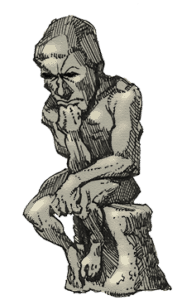I was eating popcorn and watching the Emmy’s with my friend Jim. Yes, we are both named Jim. Anyway, we were watching the Emmy’s when Jason Sudeikis won Best Lead Actor in a Comedy Series. So, I said, “Did you know he was originally created as an advertising character?”
“Jason Sudeikis?” Jim sounded startled, a handful of popcorn halfway to his mouth. “I thought he was a real person.”
“Ted Lasso,” I clarified.
“Of course, I knew that,” he said. “Ted Lasso was the main character in a campaign for NBC to help promote their coverage of Premier League football. An ad agency came up with the ‘fish out of water’ concept to help sell the American public on watching British soccer games. I saw the original ads in 2013. I bet everyone knows that. It’s on the internet.”
“Fine,” I said, taking the popcorn bowl. “But I bet you can’t name another character from a commercial that went on to become an entertainment property.”
“I can name a million of them that went the other way,” Jim told me. “Like Shrek. He did breakfast cereal and those big M&M’s. And Reese Bobby! Ricky Bobby’s dad from Talladega Nights. They just used him in a Dodge commercial. And Heineken just used Daniel Craig in a beer commercial.”
“Daniel Craig is a real guy.”
“They used James Bond, played by Daniel Craig.”
“You’re stalling,” I said. “You can’t name another advertising character that got used in entertainment.”
“It’s a trick question! There aren’t any,” Jim countered. “Right?”
“Wrong,” I pounced, “The California Raisins. They won an Emmy for their TV special on CBS in 1988 and then they got a whole cartoon series in 1989.”
“You were just waiting with that Raisins thing because you used to work at the place that animated them,” Jim complained, taking back the popcorn bowl. “Bet you can’t name another.”
“The Geico Cavemen got their own series on ABC in 2007,” I answered.
“Dang! And I actually watched that show. Well, two episodes. It wasn’t as good as the commercials. No Emmy’s there.” He shook his head. “So, you’re a character guy. Why do the California Raisins and Ted Lasso get to go from ads to winning Emmy’s while the Sun-Maid Raisin Lady, the Nasonex Bumblebee, and the CarFax Car Fox don’t?”
“Well—” I started.
“Is this going to get all technical?” he cut me off.
“No. It’s really simple. Great characters, like great stories, share three basic elements.”
“Three basic elements?” He looked skeptical
“Yeah,” I took the popcorn. “Conflict, meaning, and purpose. First, they’re driven by a conflict. Think of any good character—in advertising or entertainment. There’s something they’re struggling with that makes them interesting to watch—sometimes it’s an external thing, like another character or the situation they’re in. Usually, with the good ones, it’s some inner issue. Not so much for the Sun-Maid Raisin Lady. She’s never exhibited a conflict, so she’s not very engaging.”
“She has to fill her basket with those raisins,” Jim countered.
“Is that hard for her?”
“No.” He munched a handful of popcorn. “Ok. I see what you mean. That’s why she’s boring. And second?”
“Meaning. A great character suggests a viewpoint about how to live your life—like Shrek is about how people are full of hidden depth and you shouldn’t judge a book by its cover.”
“Shrek is about that?” Jim pushed back. “That sounds deep for an animated ogre.”
“All the best characters hint at deeper meaning. That’s why they feel relevant. They reinforce an idea about how to cope with the struggles of life.”
“Shrek though?”
“Think about the ‘onions have layers’ scene,” I reminded.
“Everybody likes parfait,” Jim quoted Donkey. “Yeah. I guess. So, you’re saying the Nasonex Bee isn’t so good because it doesn’t mean anything more than, ‘Use Nasonex?’”
“Exactly. But the Geico Cavemen suggested the same kind of meaning as Shrek.”
“Don’t judge a book by its cover,” Jim nodded. “Because the cavemen weren’t stupid, even though they looked like cavemen. Got it. And what’s the third thing?”
“A larger purpose.”
“The Car Fox has a purpose,” Jim noted. “He tells people to use CarFax. But I still don’t think they could make a show about him.”
“That’s a purpose, but it’s not a larger purpose,” I said. “One of the problems with a lot of advertising characters is that they only exist to promote their brand. They’re like puppets with the brand manager’s hand shoved up their back. They just say and do whatever the brand thinks will sell more stuff. They may look like entertainment characters, but they come across as self-serving shills because that’s all they are.”
“So, what’s Ted Lasso’s larger purpose?” Jim asked. “To bring a fresh perspective and optimistically try new things?”
“Sounds good to me,” I told him.
“Conflict, meaning, and purpose. That’s what it takes to make an advertising character that can carry its own Emmy-Award-winning show?”
“That’s what it takes to build a great character,” I said. “And a great character is a great character whether it’s in an ad, a TV show, a movie, or whatever.”
“Maybe I should suggest a character for my company, now that I know the secret,” Jim said, “then make millions off the TV show. Has anyone ever done a talking measuring tape as a character before?”
“Not that I’m aware of. But just be sure the measuring tape has a conflict that’s central to your brand, a meaning that makes sense in relation to your products, and a purpose you share with your consumers,” I told him.
“What now?” he demanded in faux outrage. “There’s more to it than just making up a good conflict, meaning, and purpose?”
“If it were as easy as all that,” I told him, “I’d be out of business.”
